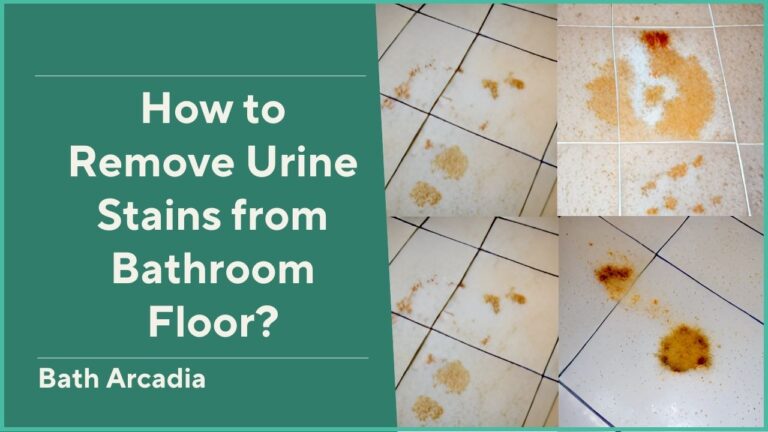Your shower curtain and liner are essential for keeping your bathroom dry and clean, but they can also become dirty and unsanitary over time due to mold, mildew, soap scum, and hard water stains. If you don’t clean them regularly, they can make your shower look unpleasant, smell bad, and even affect your health.
You don’t have to replace them every time they get grimy. You can easily clean them with some simple steps and common household products.
In this article, you will learn how to clean your shower curtain and liner by hand or machine, depending on the type of material and the level of stains. You will also learn how to prevent mold and mildew from forming on your shower curtain and liner and maintain them in good condition.
Following these tips, you will enjoy a cleaner, fresher, and healthier shower experience.
Preparation and Safety Measures
Before you start cleaning your shower curtain and liner, you need to prepare some tools and ingredients and take some safety measures. Here are some of the items you may need:
- A washing machine
- Laundry detergent
- Baking soda
- White vinegar
- Bleach (optional)
- A spray bottle
- A microfiber cloth
- A dryer or a clothesline
You also need to check the care label on your shower curtain and liner for specific instructions from the manufacturer. Some fabrics or plastics may not be suitable for machine washing or certain cleaning products.
You also need to remove any metal hooks or rings that may damage your shower curtain, liner, or washing machine.
When using cleaning products, especially bleach, make sure to wear gloves and eye protection and work in a well-ventilated area. Do not mix different cleaning products, as they may cause harmful reactions or fumes.
If you have allergies or sensitivities to certain chemicals, use natural alternatives or test a small area first.
Step-by-Step Cleaning Methods
Depending on the type of material and the condition of your shower curtain and liner, you may choose different cleaning methods. Here are some of the most common ones:
How to Clean a Fabric Shower Curtain
A fabric shower curtain is usually made of cotton, polyester, nylon, or other materials that can be washed by hand or machine.
You should always check the care label for any specific instructions from the manufacturer before washing your fabric shower curtain.
Here are the general steps to follow:
Machine Washing
- Remove the shower curtain from the hooks or rings and place it in the washing machine with a couple of towels. The towels will help balance the load and prevent wrinkles.
- Add laundry detergent and 1/2 cup of baking soda to the washer. Add 1/4 cup of white vinegar to the rinse cycle for extra cleaning power and odor removal.
- Choose a gentle cycle with warm water and the highest water level. Avoid using hot water or bleach, as they may damage or fade your fabric shower curtain.
- Once the cycle is complete, shake your shower curtain and hang it on the rod to air dry. You can also tumble dry it on low heat if the care label allows.
Hand Washing
- Fill your bathtub or sink with warm water and add a small amount of laundry detergent. You can also add 1/2 cup of baking soda and 1/4 cup of white vinegar to boost the cleaning power and remove odors.
- Submerge your shower curtain in the water and gently agitate it with your hands. Let it soak for 15 to 20 minutes.
- Drain the water and rinse your shower curtain with clean water until no soap or bubbles remain.
- Wring out the excess water and hang your shower curtain on a clothesline or a dryer to air dry.
How to Clean a Plastic Shower Curtain or Liner
A plastic shower curtain or liner is usually made of vinyl, PEVA, EVA, or other synthetic materials that can be cleaned by hand or machine with some precautions.
Alternatively, you can clean it by spraying a solution and rinsing it with water. Here are two methods to choose from:
Machine Washing
- Remove the shower curtain or liner from the hooks or rings and place it in the washing machine with a few towels. The towels will help prevent crinkling and scrub off dirt and residue.
- Add a small laundry detergent and 1/2 cup of bleach to the washer. Bleach kills mold and mildew spores, but ensure your shower curtain or liner is white or transparent to avoid damage.
- Choose a gentle cycle with cold water and the highest water level. Do not use warm or hot water, as they may melt or warp your plastic shower curtain or liner.
- Skip the spin cycle if you are washing a plastic shower curtain or liner, as it will not retain water. However, you may want to spin the towels separately.
- Shake out your shower curtain or liner and re-hang it on the rod to dry.
Hand Washing
- Remove the shower curtain or liner from the hooks or rings and spread it on a flat surface.
- Make a cleaning solution by mixing one part white vinegar and four parts water in a spray bottle.
- Spray the solution on both sides of the shower curtain or liner, focusing on any stained areas.
- Let the solution sit for 10 minutes, then wipe it off with a damp microfiber cloth.
- Rinse the shower curtain or liner with clean water from top to bottom.
- Re-hang it on the rod to dry.
Routine Maintenance Tips
The best way to keep your shower curtain and liner clean and fresh is to prevent mold and mildew from forming in the first place.
Here are some tips to help you do that:
- After each shower, pull the shower curtain closed instead of leaving it bunched up on one side. This will help it dry faster and more evenly.
- Use your bathroom fan or open a window while showering to reduce humidity and moisture in the air.
- Spray your shower curtain or liner with a vinegar solution once a week to prevent mold and mildew growth. You can also use a commercial mold and mildew remover or a bleach solution, but make sure to rinse well afterward.
- Wash your shower curtain or liner at least once a month to remove any dirt and soap scum that may accumulate on it.
- Replace your shower curtain or liner when it shows signs of wear and tear, such as holes, tears, or cracks.
Key Takeaways
- Your shower curtain and liner need regular cleaning to prevent mold, mildew, soap scum, and hard water stains from building up on them.
- You can clean your shower curtain and liner by hand or machine, depending on the type of material and the level of stains.
- You can use common household products, such as baking soda, vinegar, bleach, and laundry detergent, to effectively clean your shower curtain and liner.
- You can prevent mold and mildew from forming on your shower curtain and liner by keeping them dry, ventilated, sprayed, and washed regularly.
FAQs
Here are some FAQs based on How to Clean Your Shower Curtain and Liner:
You should clean your shower curtain and liner at least once a month to prevent mildew, bacteria, and odors.
Yes, most shower curtains and liners can be washed in the washing machine with gentle detergent and other ingredients, such as vinegar, bleach, or baking soda.
You should avoid mixing cleaning solutions, as they can cause toxic fumes. You should also avoid using hot water or the dryer for plastic curtains or liners, as they can melt or warp.
Hand-washing your shower curtain and liner is a big lift and should only be done with certain materials. You can scrub them with baking soda and warm water or soak them with vinegar or bleach in a bucket.
You can keep your shower curtain and liner cleaner longer by spraying them with a vinegar mixture weekly, rinsing them after each shower, and keeping them spread out to dry.
Conclusion
A shower curtain and liner are essential for keeping your bathroom dry and clean, but they can also become dirty and unsanitary over time due to mold, mildew, soap scum, and hard water stains.
If you don’t clean them regularly, they can make your shower look unpleasant, smell bad, and even affect your health.
You don’t have to replace them every time they get grimy. You can easily clean them with some simple steps and common household products.
Following these tips, you will enjoy a cleaner, fresher, healthier shower experience.


